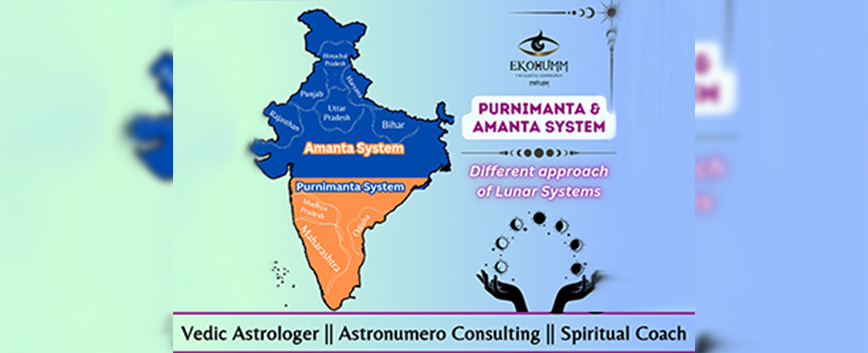


 Aug 17, 2023
Aug 17, 2023
The measurement and tracking of time have long been important aspects of human civilization. In various cultures around the world, different calendars have been developed to organize the passage of time.
One of the significant aspects of many calendars is the concept of lunar months.
Lunar months are based on the cycles of the moon, which completes approximately one orbit around the Earth in about 29.5 days. The sighting of the new moon marks the beginning of a lunar month, while the full moon signifies its end.
Basically, 'lunar month' is the basic unit of Hindu calendar. Lunar months play a significant role in many calendars worldwide, reflecting the deep connection between humans and the celestial bodies. Hindu calendar, also known as lunisolar calendar, follows the Moon's cycle. It counts lunar phases as its calendar counter.
However, there are two types of systems or traditions followed in India with respect to lunar calendars namely: 'Amanta & Purnimanta' .
In this article, we will delve into the Purnimanta and Amanta systems of lunar months and explore the connection between solar and lunar months.
According to Amanta Lunar Hindu calendar, the lunar month ends on 'no moon day', i.e., Amavasya. Hence, it's also known as the "Amavasyant" calendar.
(Amavasya + ant = ending on Amavasya).
Basically, the Amanta system divides the lunar month into two halves: the waxing phase (Shukla Paksha) and the waning phase (Krishna Paksha).
It is followed in Southern states of India like Andhra Pradesh, Assam, Gujarat, Maharashtra, Karnataka, Kerala, Tamil Nadu, West Bengal and Tripura.
And according to the Purnimanta Lunar Hindu Calendar, the lunar month ends on 'full moon day', i.e., Purnima. Hence, it has been given the name "Purnimanta" or "Purnimant."
(Purnima + ant = ending on Purnima).
Here also, the division of lunar months is into two halves but the first 15 days (waxing phase) is to be called Krishna Paksha & the next 15 days (waning phase) as Shukla Paksha.
It is followed in Northern states of India like Bihar, Chhattisgarh, Haryana, Himachal Pradesh, Jammu and Kashmir, Jharkhand, Madhya Pradesh, Orissa, Punjab, Rajasthan, Uttarakhand and Uttar Pradesh.
We can term both 'Amanta' & 'Purnimanta' systems as the 'two sides of a single coin.'
In both these Lunar Hindu calendars, the festivals still fall on the same day, or very closely, but the name of the month may be different.
Let's understand this via an example of 'Shravan' festival:
This year according to the Purnimanta system, 'Shravan' started on the 4thJuly , however in the Amanta system, it occurs 15 days later i.e. on the 18th of July 2023
Overall, by considering both systems, we gain insights into the rich tapestry of cultural practices and traditions that have evolved around lunar months throughout history.